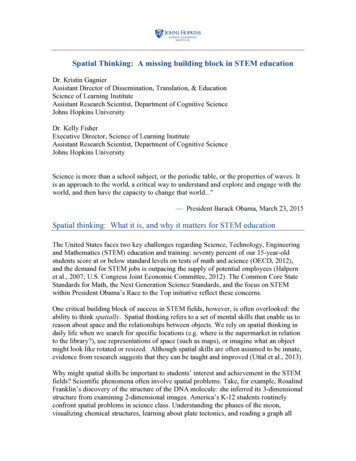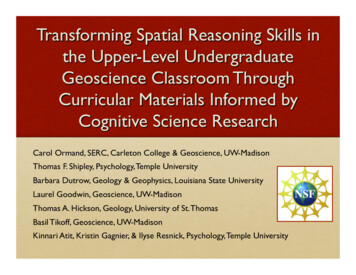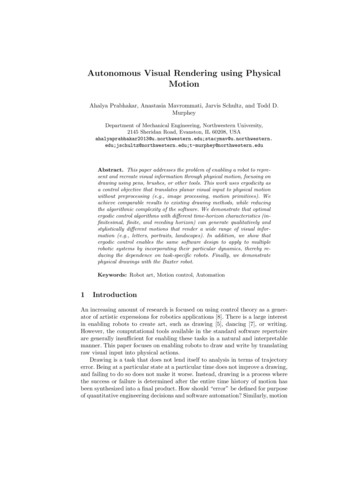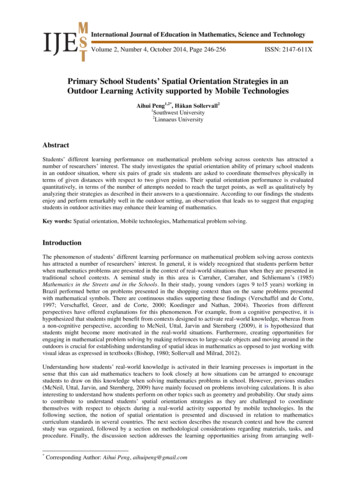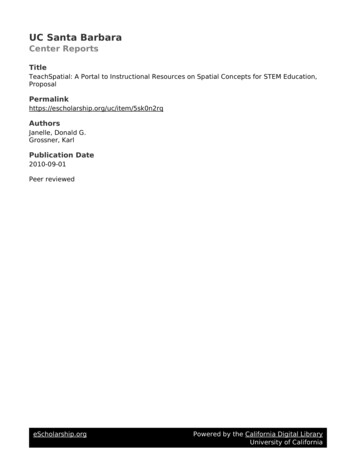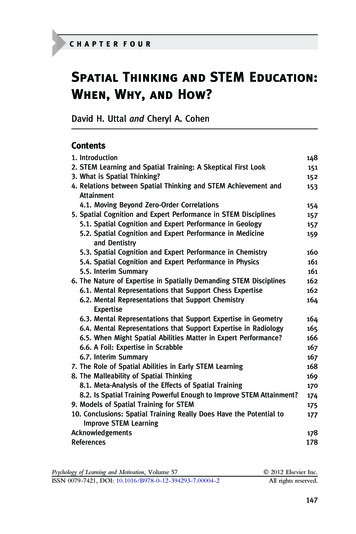
Transcription
C H A P T E R F O U RSpatial Thinking and STEM Education:When, Why, and How?David H. Uttal and Cheryl A. CohenContents1.2.3.4.IntroductionSTEM Learning and Spatial Training: A Skeptical First LookWhat is Spatial Thinking?Relations between Spatial Thinking and STEM Achievement andAttainment4.1. Moving Beyond Zero-Order Correlations5. Spatial Cognition and Expert Performance in STEM Disciplines5.1. Spatial Cognition and Expert Performance in Geology5.2. Spatial Cognition and Expert Performance in Medicineand Dentistry5.3. Spatial Cognition and Expert Performance in Chemistry5.4. Spatial Cognition and Expert Performance in Physics5.5. Interim Summary6. The Nature of Expertise in Spatially Demanding STEM Disciplines6.1. Mental Representations that Support Chess Expertise6.2. Mental Representations that Support ChemistryExpertise6.3. Mental Representations that Support Expertise in Geometry6.4. Mental Representations that Support Expertise in Radiology6.5. When Might Spatial Abilities Matter in Expert Performance?6.6. A Foil: Expertise in Scrabble6.7. Interim Summary7. The Role of Spatial Abilities in Early STEM Learning8. The Malleability of Spatial Thinking8.1. Meta-Analysis of the Effects of Spatial Training8.2. Is Spatial Training Powerful Enough to Improve STEM Attainment?9. Models of Spatial Training for STEM10. Conclusions: Spatial Training Really Does Have the Potential toImprove STEM LearningAcknowledgementsReferencesPsychology of Learning and Motivation, Volume 57ISSN 0079-7421, DOI: 174175177178178Ó 2012 Elsevier Inc.All rights reserved.147
148David H. Uttal and Cheryl A. CohenAbstractWe explore the relation between spatial thinking and performance and attainment in science, technology, engineering and mathematics (STEM) domains.Spatial skills strongly predict who will go into STEM fields. But why is thistrue? We argue that spatial skills serve as a gateway or barrier for entry intoSTEM fields. We review literature that indicates that psychometrically-assessedspatial abilities predict performance early in STEM learning, but become lesspredicative as students advance toward expertise. Experts often have mentalrepresentations that allow them to solve problems without having to usespatial thinking. For example, an expert chemist who knows a great deal aboutthe structure and behavior of a particular molecule may not need to mentallyrotate a representation of this molecule in order to make a decision about it.Novices who have low levels of spatial skills may not be able to advance tothe point at which spatial skills become less important. Thus, a program ofspatial training might help to increase the number of people who go intoSTEM fields. We review and give examples of work on spatial training, whichshow that spatial abilities are quite malleable. Our chapter helps to constrainand specify when and how spatial abilities do (or do not) matter in STEMthinking and learning.1. IntroductionThere is little doubt that the United States faces a serious, and growing,challenge to develop and educate enough citizens who can perform jobs thatdemand skill in science, technology, engineering, and mathematics (STEM)domains. We do not have enough workers to fill the demand in the short run,and the problem is only likely to get worse in the long run (Kuenzi,Matthews, & Mangan, 2007; Mayo, 2009; Sanders, 2009). Addressing the“STEM challenge” is thus a concern of great national priority. Forexample, President Obama noted that “Strengthening STEM education isvital to preparing our students to compete in the 21st century economyand we need to recruit and train math and science teachers to support ournation’s students.” (White House Press Release, September 27, 2010).In this paper we focus on one factor that may influence people’s capacityto learn and to practice in STEM-related fields: spatial thinking. The contribution of spatial thinking skill to performance in STEM-related fields holdseven when controlling for other relevant abilities, such as verbal and mathematical reasoning (Wai, Lubinski, & Benbow, 2010). Moreover, substantialresearch has established that spatial skills are malleable–that they respondpositively to training, life experiences, and educational interventions(e.g., Baenninger & Newcombe, 1989; Uttal, Meadow, Hand, Lewis,Warren, & Newcombe, Manuscript in publication. Terlecki, Newcombe,& Little, 2008; Wright, Thompson, Ganis, Newcombe, & Kosslyn, 2008).
Spatial Thinking and STEM Education: When, Why, and How?149Many STEM fields seem to depend greatly on spatial reasoning. Forexample, much of geology involves thinking about the transformation ofphysical structures across time and space. Structural geologists need to inferthe processes that led to the formation of current geological features, andthese processes often, if not always, are spatial in nature. For example,consider the geological folds shown in Figure 1. Even to the novice, itseems obvious that this structure must have stemmed from some sort oftransformation of rock layers. Opposing tectonic plates created extremeforces which then pushed the rocks into the current configuration. Thestructural geologist’s job is in essence to “undo” these processes anddetermine why and how the mountains take the shape and form thatthey do. This is but one of an almost infinite number of spatial andtemporal problems that form the field of geology.Although the importance of spatial thinking may be most obvious ingeology, it is equally important in other STEM fields. For example, a greatdeal of attention is devoted in chemistry to the study and behavior ofisomers, which are compounds with identical molecular compositions, butdifferent spatial configurations. A particularly important spatial propertyof isomers is chirality, or handedness. As illustrated in Figure 2, a moleculeis chiral if its mirror image cannot be superimposed on itself throughrotation, translation, or scaling. Molecules that are chiral opposites arecalled enantiomers. Chemistry teachers often use a classic analogy to explainchirality, namely, the spatial relation between a person’s right and lefthand. Although they share the same set of objects (fingers and thumbs),Figure 1 Geological folds in the Canadian Rockies. The arrows point to one aspect ofthe structure that was created through folding. (B. Tikoff, personal communication,December 28, 2011). (Photograph courtesy of Steve Wojtal, used with permission.)(For color version of this figure, the reader is referred to the web version of this book.)
150David H. Uttal and Cheryl A. CohenFigure 2 Chirality. Although the two molecules above have the same set of spatialrelations, it is not possible to transform one molecule into the other through spatialtransformations such as rotation, translation or scaling. The same property holds truefor the relation between our two hands. (Image is in the public domain.) (For colorversion of this figure, the reader is referred to the web version of this book.)and the same set of relations among these objects, it is not possible tosuperimpose the left hand onto the right hand. Chemists and physicistshave adopted this embodied metaphor, often referring to left- and righthand configurations of molecules.Chirality matters greatly because although enantiomers share the sameatoms, their spatial differences greatly affect how the isomers behave inchemical reactions. A classic example was the failure to distinguishbetween enantiomers of the Thalidomide molecule. One version ofthis drug acted as an effective treatment for morning sickness, and wasprescribed in the early 1960s to many thousands of pregnant women.Unfortunately, its enantiomer caused very serious birth defects. Chemistsand pharmacists did not realize that this spatial, but not structural, difference was important until it was too late (Fabro, Smith, & Williams,1967; See Leffingwell, 2003 for other examples). Both forms wereincluded in the dispensed drug, which led to notoriously severe birthdefects.As in our discussion of geology, this is but one of a great number ofspatial relations that are critically important in chemistry. As manyresearchers (and students) have noted, learning to understand systems ofspatial relations among molecules, and the representations of these molecules pictorially or with physical blocks, is one of the central challengesin learning chemistry.
Spatial Thinking and STEM Education: When, Why, and How?1512. STEM Learning and Spatial Training:A Skeptical First LookThe spatial demands of STEM learning and practice raise intriguingquestions: can teaching people to think spatially lead to improvements inSTEM education? Should spatial training be added to the arsenal of toolsand techniques that educators, researchers, businesses, and the military areusing to try to increase competence in STEM-relevant thinking? There isgrowing enthusiasm about the promise of training spatial thinking, andsome researchers and educators have developed and refined spatial trainingprograms that are specifically designed to enhance spatial thinking andprevent dropout from STEM fields. For example, Sorby & Baartmans(1996, 2000) developed a ten-week course to train spatial thinking skillsthat are important early in the college engineering curriculum. Theprogram has been very successful, leading to large and substantial gainsnot only in engineering retention but also in psychometrically-assessedspatial ability.However, before embarking on a large-scale program of spatial training,we need to think very carefully and skeptically about how and why spatialthinking is, and is not, related to STEM achievement. We want educationalinterventions to be based on the strongest possible evidence. Is the existingevidence strong enough to support the recommendation that spatialtraining should be instituted to raise the number of STEM-qualifiedworkers and students? The many reported correlations between STEMachievement and spatial ability are a necessary first step, but simple correlations are obviously not enough to justify the implementation of large-scaleimplementations. Our skepticism is also justified by preliminary empiricalfindings. For example, the results of several studies indicate that the relationbetween spatial skills and STEM achievement grows smaller as expertise ina STEM field increases.Our primary goal therefore is to review and synthesize the existingevidence regarding the relation between spatial skills and STEM achievement. We take a hard look at the evidence, and we also consider when,why, and how spatial abilities do and do not relate to STEM learningand practice, both at the expert and novel levels. In addition to its practicalimportance, the questions we raise here have important implications forcognitive psychology. For example, we discuss what happens at the levelof cognitive representation and processing when one becomes an expertin a spatially-rich STEM domain. Our discussion sheds substantial lightnot only on the role of spatial reasoning in STEM but also on the characterization of expert knowledge in spatially-rich or demanding contentdomains.
152David H. Uttal and Cheryl A. CohenWe begin by discussing what spatial thinking is and how it has beendefined. We then consider the existing evidence that spatial ability andSTEM performance are related. This review indicates that spatial abilitiesdo predict both entrance into STEM occupations and performance onSTEM-related tasks in novices. However, the evidence for a relationshipbetween spatial skills and STEM occupations and performance is weakerand less consistent in for STEM experts. For example, whether expert geologists succeed or fail on an authentic geology task seems to have little to dowith their level of spatial skill (Hambrick et al., 2011). We then considerpossible causes of this surprising, perhaps even paradoxical, novice-expertdifference. We conclude that much of the difference stems from howexperts represent and process domain-specific knowledge. As domainspecific knowledge increases, the need for the abilities measured bytypical spatial abilities tests goes down.This pattern of results suggests a specific role for spatial training in STEMeducation: spatial training may help novices because they rely more on decontextualized spatial abilities than experts do. Therefore, spatial trainingmight help to prevent a consistent problem in STEM education: Frequentdropout of students who enter STEM disciplines (but fail to complete theirdegrees and often go into non-STEM fields). We then consider research onthe effectiveness of spatial training, including a recent meta-analysis (Uttalet al., (Manuscript accepted for publication)) that has shown that spatialskills are quite malleable, and that the effects of training can endure overtime and can transfer to other, untrained tasks. We conclude by makingspecific recommendations about when, whether, and why spatial trainingcould enhance STEM attainment. We also point the way to the next stepsin research that will be needed to fully realize the potential of spatial training.3. What is Spatial Thinking?Any discussion of a psychological construct such as spatial thinkingshould begin with a clear definition of what it is. Unfortunately, providinga good definition is not nearly as easy as one would hope or expect. It iseasy enough to offer a general definition of spatial thinking, as we alreadydid above. However, it turns how to be much harder to answer questionssuch as the following: is there one spatial ability, or are there many? If thereare many kinds of spatial abilities, how do they relate to one another? Canwe speak about how spatial information is represented and processed independent of other abilities (Gershmehl & Gershmehl, 2007).Many factor-analytic studies have addressed these sorts of questions.However, these studies have not yielded consistent results, in part becausethe resulting factors are greatly affected by the tests that are used, regardless
Spatial Thinking and STEM Education: When, Why, and How?153of what the researcher intended the test to measure (Linn & Peterson, 1985;Hegarty & Waller, 2005). Theoretical analyses, based on the cognitiveprocesses that are involved, have proved somewhat more promising,although there is still no consensus as to what does and does not countas spatial thinking (Hegarty & Waller, 2005).Generally speaking, most of the research linking spatial abilities andSTEM education has focused on what Carroll (1993) termed spatialvisualization, which is the processes of apprehending, encoding, andmentally manipulating three-dimensional spatial forms. Some spatialvisualization tasks involve relating two-dimensional representations tothree-dimensional representations, and vice versa. Spatial visualization isa sub-factor that is relevant to thinking in many disciplines of science,including biology (Rochford, 1985; Russell-Gebbett, 1985), geology(Eley, 1983; Kali & Orion, 1996; Orion, Ben-Chaim, & Kali, 1997),chemistry (Small & Morton, 1983; Talley, 1973; Wu & Shah, 2004), andphysics (Kozhevnikov, Motes, & Hegarty, 2007; Pallrand & Seeber, 1984).As applied to particular domains of science, spatial visualization tasksinvolve imagining the shape and structure of two-dimensional sections, orcross sections, of three-dimensional objects or structures. Mental rotation issometimes considered to be a form of spatial visualization, although otherresearchers consider it to be a separate factor or skill (Linn & Peterson, 1985).Although it is not always possible to be as specific as we would like aboutthe definition of spatial skills, it is possible to be clearer about what psychometric tests do not measure: complex, expert reasoning in scientificdomains. By definition, most spatial abilities tests are designed to isolatespecific skills or, at most, small sets of spatial skills. They therefore are usuallydeliberately de-contextualized; they follow the traditional IQ testing modelof attempting to study psychological abilities independent of the material onwhich they are used. For example, at least in theory, a test of mental rotationis supposed to measure one’s ability to rotate stimuli in general. As wediscuss below, the kinds of knowledge that psychometric tests typicallymeasure may therefore become less important as novices advance towardbecoming experts. We therefore need to be very careful about assumingthat complex spatial problems in STEM domains are necessarily solved usingthe kinds of cognitive skills that psychometric tests tap.4. Relations between Spatial Thinkingand STEM Achievement and AttainmentMany studies have shown that there are moderate-to-strongcorrelations between various measures of spatial skills and performancein particular STEM disciplines. For example, a variety of spatial skills
154David H. Uttal and Cheryl A. Cohenare positively correlated with success on three-dimensional biology problems (Russell-Gebbett, 1985). Rochford (1985) found that students whohad difficulty in spatial processes such as sectioning, translating, rotatingand visualizing shapes also had difficulty in practical anatomy classes.Hegarty, Keehner, Cohen, Montello, and Lippa (2007) established thatthe ability to infer and comprehend cross sections is an important skillin comprehending and using medical images such as x-ray andmagnetic resonance images. The ability to imagine cross sections,including the internal structure of 3-D forms is also central to geology,where it has been referred to as “visual penetration ability” (Kali &Orion, 1996; Orion, Ben-Chaim, & Kali, 1997). Understanding thecross-sectional structure of materials is a fundamental skill of engineering(Duesbury & O’Neil, 1996; Gerson, Sorby, Wysocki, & Baartmans,2001; Hsi, Linn, & Bell, 1997; Lajoie, 2003). These and many similarfindings led Gardner (1993) to conclude that “it is skill in spatial abilitywhich determines how far one will progress in the science” (p. 192).(See Shea, Lubinski, & Benbow, 2001, for additional examples).Thus, there is little doubt that zero-order correlations between variousspatial measures and STEM outcomes are significant and often quite strong.But there is an obvious limitation with relying on these simple correlations:the third variable problem. Although spatial intelligence is usually the firstdivision in most hierarchical theories of intelligence, it is obviously correlated with other forms of intelligence. People who score highly on testsof spatial ability also tend to score at least reasonably well on tests of otherforms of intelligence, such as verbal ability. For example, although currentchemistry professors may have performed exceptionally well on spatialability tests, they are likely as well to have performed reasonably well onthe verbal portion of the SAT, a college admissions test that is used widelyin the United States. The observed correlations between spatial ability andachievement therefore must be taken with a grain of salt because of thestrong possibility that their correlations are due to unidentified variables.4.1. Moving Beyond Zero-Order CorrelationsFortunately, some studies have controlled more precisely for several othervariables, using multiple regression techniques. For example, Lubinski,Benbow and colleagues (e.g., Shea et al., 2001; Wai, Lubinski,& Benbow, 2009) have demonstrated a unique predictive role for spatialskills in understanding STEM achievement and attainment. Theseresearchers used large-scale datasets that often included tens of thousandsof participants. In general, the original goal of the research was not(specifically) to investigate the relation between spatial skills and STEM,but the original researchers did include enough measures to allow futureresearchers to investigate these relations.
Spatial Thinking and STEM Education: When, Why, and How?155Benbow and Stanley (1982) studied the predictive value of spatial abilitiesamong gifted and talented youth enrolled in the Study of MathematicallyPrecocious Youth. To enter the study, students took several tests in middleschool, including both the SAT Verbal and the SAT Math. Students alsocompleted two measures of spatial ability, the Space Relations andMechanical Reasoning subtests of the Differential Aptitude Test. In manycases, the original participants have been followed for thirty years or more,allowing the researchers to assess the long-term predictive validity of spatialtests on (eventual) STEM achievement and attainment.This work showed that psychometrically-assessed spatial skills area strong predictor of STEM attainment. The dependent variable here isthe career that participants eventually took up. Even after holding constantthe contribution of verbal and mathematics SAT, spatial skills contributedgreatly to the prediction of outcomes in engineering, chemistry, and otherSTEM disciplines. These studies clearly establish a unique role of spatialskills in predicting STEM achievement.However, one potential limitation is that they were initially based ona sample that is not representative of the general U.S. population. As itsname implies, the Study of Mathematically Precocious Youth is not a representative sample of American youth. To be admitted to the study, youthhad to be (a) identified in a talent search as being among the top 3% inmathematics, and then (b) score 500 or better on both the Verbal andMathematics SAT at 12- to14-years of age. In combination, these selectioncriteria resulted in a sample that represented the upper 0.5% of Americanyouth at the time of testing (1976e78) (Benbow & Stanley, 1982).It is reasonable to ask whether the results are limited to this highlyselected sample (Wai et al., 2009). If so, they would not provide a solidfoundation for a program of spatial training to facilitate STEM learningamong more typical students. For these reasons, Wai et al. extended theirwork to more diverse samples. They used the Project Talent database,which is a nationally representative sample of over 400,000 Americanhigh school students, approximately equally distributed across grades9e12. The participants were followed for 19 years, again allowing theresearchers to predict ultimate career choices. The results in the morerepresentative sample were quite similar to those of the project talentdataset, and hence it seems quite likely that spatial skills indeed area unique, specific predictor of who goes into STEM.Figure 3 provides a visual summary of Wai et al’s findings on the relationsbetween cognitive abilities assessed in high school and future career choice.The figure includes three axes, representing Verbal, Mathematical andSpatial ability on the X, Y, and Z axes, respectively. The scores areexpressed as z-scores; the numbers on the axes represent deviations fromzero expressed in standard deviation units. The X and Y axes are easy tounderstand. For example, the 23 participants who ended up in science
156David H. Uttal and Cheryl A. CohenFigure 3 Results from Wai, Lubinski, and Benbow (2009). The X axis representsMath SAT, and the Y axis represents Verbal SAT, expressed in standard deviationunits. The arrows are a third, or Z, dimension. The length of the arrow representsthe unique contribution of the spatial ability test to predicting eventual career.(Reprinted with permission of the American Psychological Association.)occupations scored about 0 .40 SD above the mean on the SAT Math. The Zaxis is represented by the length of the vectors extending from the pointrepresenting the intersection of the X and Y axis. The length of eachvector can be construed as the value-added of knowing the spatial score inpredicting entry into the particular career. Note that the vectors are longand in the positive direction for all STEM fields. Moreover, spatial abilityalso strongly predicts entry into business, law, and medicine, but in thenegative direction. Clearly, if one wants to predict (and perhaps ultimatelyaffect) what careers students are likely to choose, knowing their level ofspatial skills is critically important (Wai et al., 2009).Moreover, there appears to be no upper limit on the relation betweenspatial skills and STEM thinking. The relation between spatial skill andSTEM attainment held even several standard deviations from the mean;the most spatially talented youth were the most likely to go into STEM fields,even at the very upper ends of the distribution of the spatial abilities test.In summary, psychometrically-assessed spatial ability strongly predictswho does and does not enter STEM fields. Moreover, this relation holdstrue even after accounting for other variables, such as Mathematics and
Spatial Thinking and STEM Education: When, Why, and How?157Verbal Aptitude. In fact, in some fields, spatial ability contributes moreunique variance than SAT scores do to the prediction of STEM achievement and attainment. Wai et al. (2009) noted that the evidence relatingspatial ability and future STEM attainment is exceptionally strong,covering 50 years of research with more than 400,000 participants, withmultiple datasets converging on very similar conclusions.5. Spatial Cognition and Expert Performancein STEM DisciplinesThe results presented thus far make a strong case for the importance ofspatial reasoning in predicting who goes into STEM fields and who stays inSTEM. But why is this true? At first glance, the answer seems obvious:STEM fields are very spatially demanding. Consequently, those whohave higher spatial abilities are more able to perform the complex spatialreasoning that STEM requires. It makes sense that no upper limit on therelation has been identified; the better one is at spatial skills, the betterone is at STEM. On this view, there is a strong relation between spatialability and STEM performance, at all levels of expertise because spatial abilities either limit or enhance whether a person is able to perform the kinds ofspatial thinking that seem to characterize STEM thinking (See Stieff, 2004,2007 for a more detailed account and critique of this explanation).But this seemingly simple answer turns out not to be so simple. In thissection we present a seeming paradox: even though spatial abilities arehighly correlated with entry into a STEM field, they actually tend tobecome less important as a student progresses to mastery and ultimatelyexpertise. Despite the well-replicated correlations between spatial abilitiesand choosing a STEM career, experts seem to rely surprisingly little onthe kinds of spatial abilities that are tested in spatial ability tests. In thenext section we consider the literature that supports these claims.We note at the outset of this discussion that research on the spatial abilities and their role in STEM expertise is rather limited. Although there aremany studies of spatial ability in STEM learners, many fewer have investigated the role of spatial ability in expert performance. Thus we are limitedto some extent in judging the replicability and generalizability of the findings we report. Moreover, our choice of which disciplines to discuss islimited by the availability of research on expertise in the STEM disciplines.5.1. Spatial Cognition and Expert Performance in GeologyPerhaps the best examples come from geology. As we have alreadynoted, structural geology is basically a science of spatial and temporal
158David H. Uttal and Cheryl A. Cohentransformations, so if one were looking for relations between spatial abilityand expert performance, this field would seem to be a good place to start.Hambrick et al. (2011) investigated the role of psychometrically-assessedspatial ability in expert and novice performance in a real-worldgeosciences task, bedrock mapping. Starting with a blank map, geologistsor geology students were asked to map out the underlying structures ina given area, based on the observable surface features. This task wouldseem to require domain-specific knowledge about the kinds of rocks thatmight be found in given geological areas or are associated with givenstructures. At the same time, it would seem to require spatial reasoning,as the geologist must make inferences about how forces transformedunderlying rock beds to produce the observed structured.The study was conducted as part of a geology research and trainingcamp, in the Tobacco Mountains of Montana. On Day 1, participantstook several tests of both geospatial knowledge and cognitive ability,including spatial skills. On Day 2, participants were driven to four differentareas and heard descriptions of the rock structures found there. They werethen asked to complete the bedrock mapping task for that area. Eachmap was compared to a correct map that was generated by two experts.Scores were derived by comparing the participant’s drawn map toa computerized, digital version of the correct map. This method resultedin a very reliable deviation score, which was then converted to a map accuracy percentage.The primary results are presented in Figure 4, which is adapted fromHambrick et al. (2011). The dependent variable (shown on the Y axis) wasaverage map accuracy. As the graph indicates, there was a significantinteraction between visuospatial ability and geospatial knowledge. Thegraph is based on median splits of the two independent variables. For thoseFigure 4 Results from Hambrick et al. (2011) spatial ability and expert geologyperformance. “GK” refers to geology knowledge.
Spatial Thinking and STEM Education: When, Why, and How?159with high geospatial knowledge, visuospatial ability did not affectperformance on the bedrock mapping task. However, there wasa significant effect of visual spatial ability in the low geospatial-knowledgegroup: those with high visual spatial ability performed well; theirperformance nearly matched that of the high geospatial knowledge group.However, individuals who had both low visuospatial ability and lowgeospatial knowledge performed much worse. Although not sho
2. STEM Learning and Spatial Training: A Skeptical First Look The spatial demands of STEM learning and practice raise intriguing questions: can teaching people to think spatially lead to improvements in STEM education? Should spatial training be added to the arsenal of tools and techni

